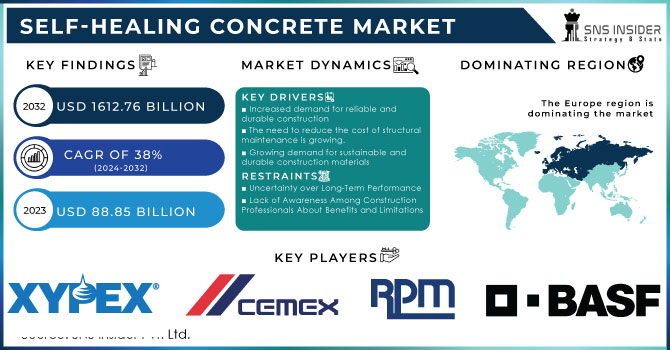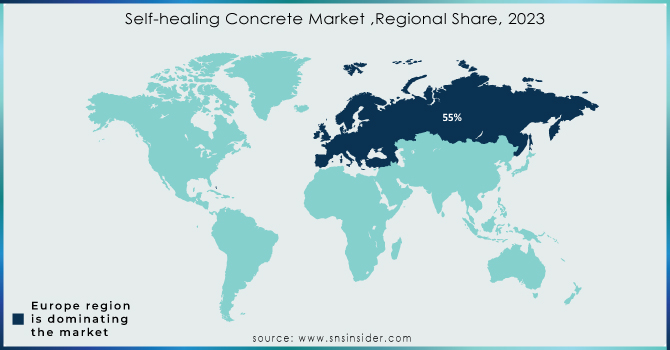REPORT SCOPE & OVERVIEW:

Get More Information on Self-healing Concrete Market - Request Sample Report
The Self-healing Concrete Market Size was valued at USD 88.85 Billion in 2023 and is expected to reach USD 1612.76 Billion by 2032 and grow at a CAGR of 38% over the forecast period 2024-2032.
Regular concrete, a workhorse of construction, has a major crack. These cracks allow water and harmful substances to seep in, accelerating degradation from weather, chemicals, and freeze-thaw cycles. Additionally, exposed reinforcement steel suffers from rust, compromising structural integrity. Repairs for cracked concrete are not only expensive but also time-consuming.
Self-healing concrete, a revolutionary material with the potential to transform the construction industry. This innovative material comes in two main forms:
Encapsulated Healing Agent: Microscopic capsules embedded within the concrete contain a healing agent like resin or epoxy. When a crack appears, these capsules break open, releasing the agent to automatically fill the void.
Bio-concrete: This type utilizes bacteria that produce calcium carbonate (limestone) in the presence of water. When a crack develops, water triggers the bacteria to produce limestone, effectively plugging the crack.
Studies suggest it can significantly reduce crack formation by up to 90%. Additionally, it has the potential to be 100% stronger than conventional concrete, leading to more robust structures. Perhaps the most exciting benefit is the potential to double the lifespan of concrete structures, drastically reducing maintenance costs and environmental impact.
MARKET DYNAMICS
KEY DRIVERS:
-
Increased demand for reliable and durable construction
Traditional concrete is prone to cracking, which can lead to water infiltration, corrosion of steel reinforcement, and ultimately, structural failure. Self-healing concrete can help to mitigate these problems by automatically repairing cracks, which can extend the lifespan of structures and reduce the need for maintenance.
-
The need to reduce the cost of structural maintenance is growing.
-
Growing demand for sustainable and durable construction materials
RESTRAIN:
-
Uncertainty over Long-Term Performance
Self-healing concrete is a relatively new technology, and there is still some uncertainty over its long-term performance. More research is needed to determine how well this concrete will perform over decades of use.
-
There may be a lack of awareness among some construction professionals about its benefits and limitations.
OPPORTUNITY:
-
Self-healing concrete currently sees use in civil infrastructure, but there's room for growth in other areas
Self-healing concrete offers exciting possibilities beyond civil infrastructure. Imagine underground structures like tunnels and basements autonomously repairing cracks and leaks. Marine environments, where seawalls, piers, and offshore structures face constant corrosion, could benefit greatly from reduced maintenance needs. Precast concrete elements, including pipes and slabs, could be imbued with self-healing properties, minimizing future maintenance burdens.
-
Some governments are already promoting the use of sustainable construction materials.
CHALLENGES:
-
Cold climates or lack of moisture can hinder the bacteria's ability to heal cracks
Some self-healing methods, like those using bacteria, rely on specific environmental conditions to function effectively.
Russia-Ukraine War's Potential Impact on Self-Healing Concrete Market
The war is expected to slow down global construction industry growth. Pre-war forecasts predicted 3.9% growth in 2023, but this might be revised downwards, suggesting a potential decrease in overall construction spending that could impact investment in new technologies like self-healing concrete.
Global military spending reached $2.1 trillion in 2021, with Russia and Ukraine expected to significantly increase their spending in 2023 due to the war. While the exact amount diverted from research budgets is unknown, such a spending shift suggests potential cuts to research funding across various sectors, potentially impacting research into self-healing concrete.
Economic Uncertainty Impacts Construction Industry In 2023
Uncertainty hangs heavy over the construction industry in 2023. High inflation and rising interest rates make predicting future projects and costs a challenge. While existing backlogs, especially in energy and data centers, keep companies busy, a slowdown is expected later in the year. Persistent supply chain issues caused by transportation bottlenecks and geopolitical tensions further complicate matters. To navigate these disruptions, the industry may need to adopt new business models and partnerships. The situation is compounded by a significant shortage of skilled workers, which hinders the industry's ability to meet project demands despite a strong pipeline. With inflation on the rise and the labor market downfall, companies may be forced to raise wages and benefits to attract and retain workers.
KEY MARKET SEGMENTS
By Form:
-
Intrinsic
-
Vascular
-
Capsule Based
In 2023, Vascular based self-healing concrete dominated the market, which uses tubes filled with healing agents threaded throughout the structure, held the biggest market share of over 68%.
Capsule-based self-healing concrete is fastest growing market. These tiny capsules are mixed directly into the concrete and burst open when cracks appear, releasing a healing agent that fills the gap. This makes them more convenient for widespread use in large-scale projects.
By End Use
-
Residential
-
Industrial
-
Commercial
-
Infrastructure
In 2023, self-healing concrete saw its biggest use accounting for over 63% of sales in infrastructure projects like bridges and roads. Construction companies are increasingly working with developers to bring this technology to market, all with the goal of making infrastructure projects last longer.
REGIONAL ANALYSIS
Europe holds supreme position in the self-healing concrete market, holding over global share of 55% and experiencing significant projected growth. A strong European construction industry, fueled by positive economic trends, is a key driver.
North America, a mature market for concrete, boasts innovation from established multinational companies heavily invested in R&D.
The Asia Pacific region witnesses a construction boom due to its growing population and economic powerhouses like China and India. This indirectly creates high demand for self-healing concrete as the construction materials market expands. All three regions are positioned for substantial growth in this promising technology.

Get Customized Report as per Your Business Requirement - Request For Customized Report
REGIONAL COVERAGE:
North America
-
US
-
Canada
-
Mexico
Europe
-
Eastern Europe
-
Poland
-
Romania
-
Hungary
-
Turkey
-
Rest of Eastern Europe
-
-
Western Europe
-
Germany
-
France
-
UK
-
Italy
-
Spain
-
Netherlands
-
Switzerland
-
Austria
-
Rest of Western Europe
-
Asia Pacific
-
China
-
India
-
Japan
-
South Korea
-
Vietnam
-
Singapore
-
Australia
-
Rest of Asia Pacific
Middle East & Africa
-
Middle East
-
UAE
-
Egypt
-
Saudi Arabia
-
Qatar
-
Rest of Middle East
-
-
Africa
-
Nigeria
-
South Africa
-
Rest of Africa
-
Latin America
-
Brazil
-
Argentina
-
Colombia
-
Rest of Latin America
Key players
Some of the major players in the Self-healing Concrete Market are BASF SE, Kryton, Cemex, RPM International, Basilisk, Sika AG, PENETRON, Xypex Chemical Corporation, GCP Applied Technologies, Hycrete, Inc., and other players.
RECENT TRENDS
-
Sika announced a significant acquisition in November 2021. They agreed to purchase MBCC Group, previously BASF Construction Chemicals, from a subsidiary of Lone Star Funds, a global private equity firm. The deal was valued at EUR 5.2 billion.
-
In July 2021, JP Concrete, the world's leading producer of environmentally friendly prefabricated steel products, concluded an agreement with Basilisk, a pioneer in self-healing materials technology, to use its new Sensicrete material.
| Report Attributes | Details |
|---|---|
| Market Size in 2023 | US$ 88.85 Bn |
| Market Size by 2032 | US$ 1612.76 Bn |
| CAGR | CAGR of 38% From 2024 to 2032 |
| Base Year | 2023 |
| Forecast Period | 2024-2032 |
| Historical Data | 2020-2022 |
| Report Scope & Coverage | Market Size, Segments Analysis, Competitive Landscape, Regional Analysis, DROC & SWOT Analysis, Forecast Outlook |
| Key Segments | • By Form (Intrinsic, Vascular, Capsule Based) • By Application (Residential, Commercial, Industrial, Infrastructure) |
| Regional Analysis/Coverage | North America (US, Canada, Mexico), Europe (Eastern Europe [Poland, Romania, Hungary, Turkey, Rest of Eastern Europe] Western Europe] Germany, France, UK, Italy, Spain, Netherlands, Switzerland, Austria, Rest of Western Europe]), Asia Pacific (China, India, Japan, South Korea, Vietnam, Singapore, Australia, Rest of Asia Pacific), Middle East & Africa (Middle East [UAE, Egypt, Saudi Arabia, Qatar, Rest of Middle East], Africa [Nigeria, South Africa, Rest of Africa], Latin America (Brazil, Argentina, Colombia Rest of Latin America) |
| Company Profiles | BASF SE, Kryton, Cemex, RPM International, Basilisk, Sika AG, PENETRON, Xypex Chemical Corporation, GCP Applied Technologies, Hycrete, Inc., |
| Key Drivers | • Increased demand for reliable and durable construction • The need to reduce the cost of structural maintenance is growing. • Growing demand for sustainable and durable construction materials |
| Key Restraints | • Uncertainty over Long-Term Performance • There may be a lack of awareness among some construction professionals about its benefits and limitations. |

